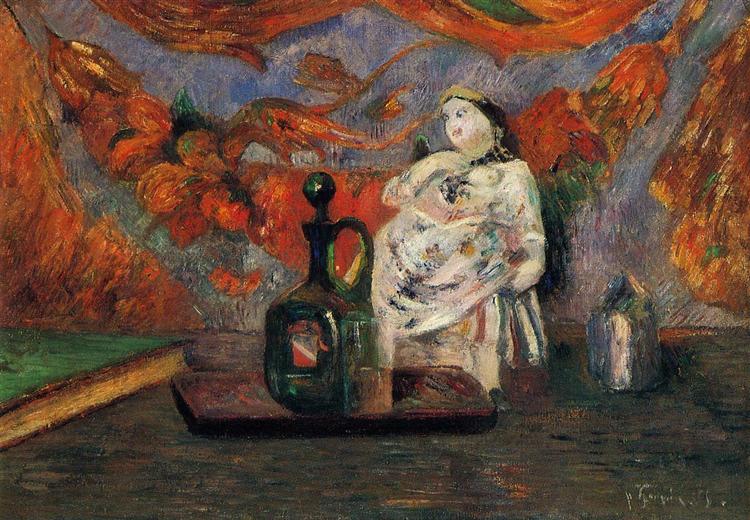Description
Paul Gauguin’s Still Life with Carafe and Ceramic Figure, dated 1885, exemplifies an early phase of the artist’s stylistic evolution, which would later be consolidated in his iconographic work in Tahiti. In this painting, Gauguin approaches the still life genre through a vivid color palette and an arrangement of elements that invite contemplation. The composition focuses on a ceramic carafe and a decorative figure that seems to engage in dialogue with its surroundings, highlighting Gauguin’s characteristic use of simplified forms and a focus on coloration.
The choice of the carafe, an everyday object, suggests a reflection on the representation of domestic life and material culture. The ceramic figure, with its stylised form and possibly influenced by elements of folk art, brings a sense of rhythm and harmony to the composition. The presence of these objects animated by colour contributes to creating an atmosphere of intimacy and serenity, traits that resonate in Gauguin's work.
The use of colour in this piece is particularly notable. The vibrant shades of blue, yellow and red not only add dynamism, but also suggest emotions that go beyond the merely representative. Gauguin was a fervent advocate of the use of colour as an expressive vehicle, and in this work he seems to achieve a balance between naturalistic representation and a freer, more subjective interpretation of colour.
The surface of the painting reveals loose brushstrokes that sometimes challenge the traditional form of the still life. This is indicative of Gauguin's transition towards a more post-impressionist aesthetic, where visual perception is nuanced by emotional and psychological interpretation. In this sense, "Still Life with Carafe and Ceramic Figure" can be seen as a precursor to the explorations that Gauguin would take further in his career.
Throughout his life, Gauguin developed an intense relationship with the art of ceramics and sculpture, something that is evident here with the inclusion of the decorative figure. This piece not only acts as a visual element in the arrangement of the scene, but also expresses a connection with the native cultures that so fascinated the artist, although this fascination would unfold more evidently in his later works in Polynesia.
Gauguin's interest in enhancing everyday life through inanimate objects reflects a desire to transcend the ephemeral. His ability to breathe life into the inanimate through the conscious use of color and form in this work makes it a testament to his artistic quest. "Still Life with Carafe and Ceramic Figure" is not just a depiction of objects; it is a study in perception and visual experience, an approach that would cement his legacy as one of the great innovators of modern art.
In short, this work offers a rich exploration of the symbiosis between colour and form and raises questions about the relationship between the viewer and the objects of the everyday world. Gauguin's legacy, both in the realm of symbolism and modern art, can be traced back to these early explorations in which he began to dissolve forms and colours in the service of emotion and personal expression.
KUADROS ©, a famous painting on your wall.
Hand-made oil painting reproductions, with the quality of professional artists and the distinctive seal of KUADROS ©.
Painting reproduction service with satisfaction guarantee. If you are not completely satisfied with the replica of your painting, we will refund 100% of your money.

